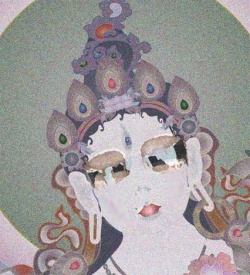The Limitations of Buddhism: A Response to My Critics by Regis Martin
- “There’s little point in writing if you can’t annoy somebody.”
So wrote the late Kingsley Amis, one of the grand old curmudgeons of English letters who, over a long and highly combative literary career, managed to annoy just about everybody. And while I do not aspire to the same heights of abrasiveness achieved by Mr. Amis, I am nevertheless certain that, from time to time, things I’ve written have managed to annoy somebody. Indeed, as recently as last week, when a dozen or more incensed readers seized upon a couple of animadversions in a piece I wrote on Buddhism October 2nd. How eagerly they set about discharging their pistols in the comment section following the essay!
So what did I do to incite such a firestorm? And why has it taken me so long before attempting even to contain the blaze? Did I find their arguments secretly compelling and was thus reduced to silence? In point of fact, I wasn’t even aware of all the thunder and lightning until this week when my editor, John Vella, a very able and nice man, dropped me a line to say what a “clobbering” I was getting among the bloggers. “It’s a bloodletting and it’s not a pretty sight,” he added. And I expect he was right but what the hell could I do? A whole busload of grandchildren having descended the week before to lay siege to my house, I was hardly in a position to compose calm rebuttals. Their arrival having coincided with the first stirrings of the storm clouds, you might say I’d been blindsided by the Buddha.
OK, so what was the warhead that set off the conflagration? Was it the fact that I’d taken such an unflattering snapshot of the Buddha? That in presenting so revered a religious icon as “a plump fatuous fellow, sitting cross-legged upon the floor with eyes closed upon the world,” I had projected a mocking tone that proved belittling in the eyes of true Buddhist believers? Ex-believers, too, who, despite confessions of having come home to Rome, continue to regard the religion they left behind as something benign and beautiful. “The central Buddhist virtue is compassion,” insisted one such reader, who complained that I’d misrepresented the faith he’d converted from seven years before. And then he accused me of “arrogance” for supposing that only Christians had cornered the market on mercy and love. It was a charge that would be echoed by others, all equally insistent that the straw man I’d constructed was no better than the caricatures one finds in Chesterton who, it turns out, was the first to pronounce on the unopened eyes of the Buddha. “Next time you write,” concluded one such critic, “write on a topic you’re familiar with.” Or, to quote my all time favorite, “If Regis Martin is a Professor of Theology he should be fired!”
Fair enough. Although on the matter of losing my job as a result of lampooning the Buddha, it is far likelier to happen at the College of the Holy Cross where the gospel of tolerance scarcely applies to people like me. Meanwhile, at the Franciscan University of Steubenville where I’m a tenured professor in a department not exactly conspicuous for courses on Buddhism, I’m at liberty to lampoon all the enemies of faith. And, really, how does one go about telling the truth about Buddhism without appearing unflattering in one’s portrait of the Buddha? There is simply no way to airbrush away the features that precisely portend the celebrated negations of being, the annihilations of self which strict Buddhist observance invites. “Everything is brought down to a few very simple truths,” writes Christopher Dawson in his scholarly study of the Mysticisms of the East; “suffering and the cause of suffering; the extinction of suffering and the way to the extinction of suffering. These are the Four Noble Truths on which the Way is founded. There is no knowledge beyond these truths and no reality outside this way. The whole of religion, the whole of philosophy, and the whole of human life are reduced to the interior way of moral and mental discipline, by which the nothingness of existence is realized and the extinction of desire and passion is attained.”
So stands the whole Buddhist system in all its tragic grandeur and simplicity. Its mysticism, says Henri de Lubac, “is the purest and most coherent there is.” Yet, he concludes, “there is no room for the living God.” Indeed, the very monism of spirit that abides at the bottom of the Buddhist barrel, absolutely precludes the possibility of a Thou to whom anyone might turn in order simply to love. “Buddhistic love,” comments Hans Urs von Balthasar, “remains ultimately without an object. Objects only exist for the uninitiated. Everything is dreamlike, incompatible with a genuine incarnation….” So radical and systemic a thrust toward an ultimate unreality can only eventuate in the destruction of the human person. “Only the self-revealing God,” says Balthasar, which means the God of Jesus Christ, “guarantees the eternal worth of the human person.”
Why must we deny that this is what Buddhism is about? Are we to suppress such bad news because it causes dismay among those whose eyes, like the Buddha’s, remain closed to the truth, to the whole reality of the extra-mental world? “When God is understood in a completely impersonal way,” writes Joseph Ratzinger in a learned aside on Buddhism, “as sheer negation with respect to everything that appears real to us, then there is no positive relationship between ‘God’ and the world. Then the world has to be overcome as a source of suffering, but it no longer can be shaped. Religion then points out ways to overcome the world, to free people from the burden of its semblance, but it offers no standards by which we can live in the world, no forms of societal responsibility within it.”
And if they still persist in the blindness of their belief that the only way to escape suffering is to extinguish desire, and thereby embrace the nothingness of nirvana, are we not obliged to point out the sheer suicide of the self such madness invites? Why is it arrogance and insensitivity to point out these things?
At the end of the day, when all the dialogue on diversity is done, this is what we need to say. That up against the Christian idea of God, the God whose most intensely dramatic expression we encounter in the image of the Pierced and Crucified Christ—who, standing wide-eyed before the world, plunges to the very bottom of its brokenness in search of sinners to save—no mysticism of mind can match the sheer range and depth of its solidarity with the world. Nor the attraction it undeniably offers to those who despite their sufferings still cling to Christ because they know that he alone came to redeem them in the very midst of their suffering and not in denial or flight from it.
How, in other words, does one convey the distinctively Christian solution without leaving everything else in the dust? That, at any rate, is the point I tried to make in the piece that, I now regret, drove not a few readers positively crackers.
Source
By Regis Martin
crisismagazine.com


